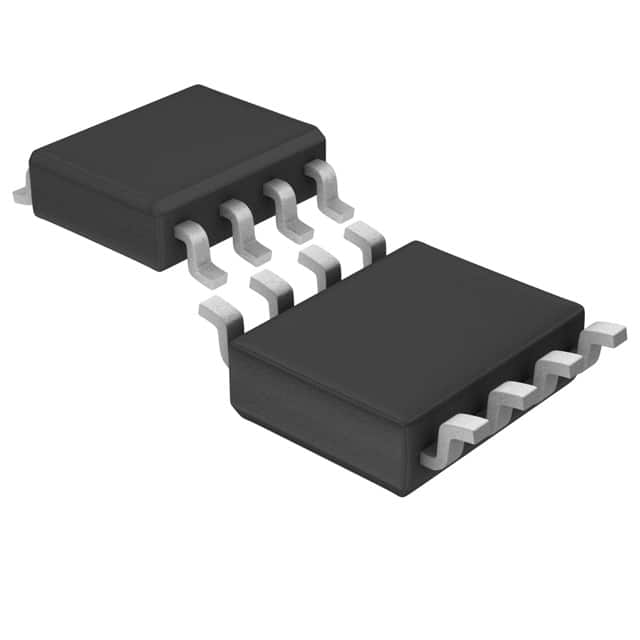LTC1428CS8-50#TRPBF
Product Overview
Category
The LTC1428CS8-50#TRPBF belongs to the category of integrated circuits (ICs).
Use
This IC is commonly used in electronic devices for voltage regulation and power management.
Characteristics
- Low dropout voltage: The LTC1428CS8-50#TRPBF has a low dropout voltage, making it suitable for applications where a stable output voltage is required.
- High efficiency: This IC offers high efficiency, ensuring optimal power utilization.
- Small package size: The LTC1428CS8-50#TRPBF comes in a compact package, allowing for space-saving designs.
- Wide input voltage range: It can operate within a wide input voltage range, making it versatile for various applications.
Package
The LTC1428CS8-50#TRPBF is available in an 8-pin surface mount package.
Essence
The essence of the LTC1428CS8-50#TRPBF lies in its ability to regulate voltage efficiently, providing a stable output voltage for electronic devices.
Packaging/Quantity
This IC is typically packaged in reels or tubes, with a quantity of 2500 units per reel/tube.
Specifications
- Input Voltage Range: 2.5V - 6V
- Output Voltage: 5V
- Dropout Voltage: 0.3V
- Maximum Output Current: 500mA
- Operating Temperature Range: -40°C to 85°C
Detailed Pin Configuration
- VIN: Input voltage pin
- GND: Ground pin
- EN: Enable pin
- FB: Feedback pin
- VOUT: Output voltage pin
- NC: No connection
- NC: No connection
- NC: No connection
Functional Features
- Low dropout voltage: The LTC1428CS8-50#TRPBF maintains a stable output voltage even when the input voltage is close to the desired output voltage.
- Enable pin: The EN pin allows for easy control of the IC's operation, enabling or disabling the voltage regulation function.
- Feedback pin: The FB pin provides feedback to the IC, ensuring accurate voltage regulation.
- Overcurrent protection: The LTC1428CS8-50#TRPBF incorporates overcurrent protection, safeguarding the connected devices from excessive current.
Advantages and Disadvantages
Advantages
- High efficiency ensures optimal power utilization.
- Wide input voltage range allows for versatile applications.
- Compact package size saves space in electronic designs.
- Overcurrent protection enhances device safety.
Disadvantages
- Limited maximum output current may not be suitable for high-power applications.
- Dropout voltage of 0.3V may affect performance in low-voltage scenarios.
Working Principles
The LTC1428CS8-50#TRPBF operates based on a voltage regulation principle known as a low dropout regulator (LDO). It compares the output voltage with a reference voltage and adjusts the internal circuitry to maintain a stable output voltage, even when the input voltage fluctuates.
Detailed Application Field Plans
The LTC1428CS8-50#TRPBF finds applications in various electronic devices that require voltage regulation and power management. Some potential application fields include:
Mobile Devices: This IC can be used in smartphones, tablets, and portable media players to regulate the voltage supplied to different components, ensuring stable operation.
IoT Devices: Internet of Things (IoT) devices often require efficient power management. The LTC1428CS8-50#TRPBF can be utilized in IoT sensors, smart home devices, and wearable technology to provide reliable voltage regulation.
Automotive Electronics: In automotive applications, this IC can be employed in power management systems, infotainment systems, and lighting control modules to maintain stable voltage levels.
Industrial Control Systems: The LTC1428CS8-50#TRPBF can be integrated into industrial control systems, such as PLCs (Programmable Logic Controllers) and motor control units, to ensure consistent and reliable power supply.
Detailed and Complete Alternative Models
- LM1117-5.0: This IC offers similar voltage regulation capabilities with a maximum output current of 800mA.
- LT1763-5: With a low dropout voltage of 0.15V, this IC provides enhanced performance for low-voltage applications.
- ADP3339AKCZ-5: This IC features a high maximum output current of 1A, making it suitable for power-hungry devices.
These alternative models provide options with varying specifications to cater to different application requirements.
In conclusion, the LTC1428CS8-50#TRPBF is an integrated circuit designed for voltage regulation and power management. Its low dropout voltage, high efficiency, and compact package make
قم بإدراج 10 أسئلة وإجابات شائعة تتعلق بتطبيق LTC1428CS8-50#TRPBF في الحلول التقنية
Sure! Here are 10 common questions and answers related to the application of LTC1428CS8-50#TRPBF in technical solutions:
Q: What is LTC1428CS8-50#TRPBF? A: LTC1428CS8-50#TRPBF is a specific model of a low-power, 5V RS485/RS422 transceiver IC.
Q: What is the purpose of LTC1428CS8-50#TRPBF? A: The purpose of LTC1428CS8-50#TRPBF is to enable reliable communication between devices using the RS485 or RS422 protocols.
Q: What are the key features of LTC1428CS8-50#TRPBF? A: Some key features include low power consumption, wide operating voltage range, high data rate support, and built-in protection mechanisms.
Q: How can I connect LTC1428CS8-50#TRPBF to my microcontroller or device? A: LTC1428CS8-50#TRPBF can be connected using standard serial communication interfaces such as UART or SPI.
Q: What is the maximum data rate supported by LTC1428CS8-50#TRPBF? A: LTC1428CS8-50#TRPBF supports data rates up to 20 Mbps, making it suitable for high-speed communication applications.
Q: Can LTC1428CS8-50#TRPBF be used in both half-duplex and full-duplex modes? A: Yes, LTC1428CS8-50#TRPBF can be configured for both half-duplex and full-duplex operation depending on the application requirements.
Q: Does LTC1428CS8-50#TRPBF have built-in protection against voltage spikes or ESD? A: Yes, LTC1428CS8-50#TRPBF has built-in protection features like overvoltage protection and ±15kV ESD protection.
Q: Can I use LTC1428CS8-50#TRPBF in industrial environments with high noise levels? A: Yes, LTC1428CS8-50#TRPBF is designed to operate reliably in harsh industrial environments with high levels of electrical noise.
Q: What is the operating temperature range of LTC1428CS8-50#TRPBF? A: LTC1428CS8-50#TRPBF can operate within a temperature range of -40°C to +85°C.
Q: Are there any application notes or reference designs available for LTC1428CS8-50#TRPBF? A: Yes, the manufacturer provides application notes and reference designs that can help you understand and implement LTC1428CS8-50#TRPBF in your specific technical solution.
Please note that the answers provided here are general and may vary depending on the specific requirements and use cases. It's always recommended to refer to the datasheet and documentation provided by the manufacturer for accurate information.


